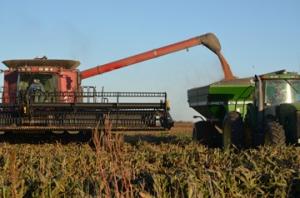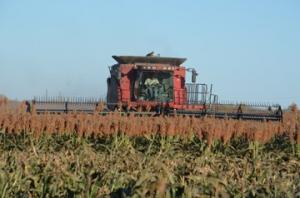Kansas sorghum farmer Adam Baldwin had a dry harvest season, which helped him complete harvest more easily than in some past years. He finished harvesting his crop the first week of November, earlier than he expected. Typically in Kansas, sorghum plants must freeze to help dry the crop to moisture levels acceptable for harvest and storage. An early freeze helped Baldwin’s plants dry faster.
As stated in the U.S. Department of Agriculture’s (USDA’s) National Agricultural Summary released Nov. 23, 2015, 94 percent of the U.S. sorghum crop has been harvested. This is 7 percent ahead of last year, and 1 percent ahead of the five-year average.
“Overall, the crop had good yields. The quality of the grain is excellent with high test weights. Plus the crop dried down very well. It wasn’t our best crop ever, but most fields averaged above 100 bushels per acre (6.3 metric tons per hectare),â€� Baldwin said.
Early in the growing season, Baldwin and other farmers believed that 2015 could be the best sorghum harvest on record. But, Baldwin said his area didn’t get much late summer or early fall rains, which hurt yields.
Despite rainfall totals that were less than ideal for Baldwin, his sorghum crop yields were higher than the 88 bushels per acre (5.5 metric tons per hectare) average for Kansas and 77 bushels per acre (4.8 metric tons per hectare) national average as reported in the Nov. 10, 2015, USDA Crop Production report.
In the September issue of Grain News, Baldwin mentioned issues with sugarcane aphids. The infestation was spotty on his farm, but nonetheless he sprayed insecticide on some of his fields.
“We had some yield loss as a result, mostly in terms of standability (stalk strength),� Baldwin said. “Dry weather plus sugarcane aphids were a lot for the plants to handle.�
Now that harvest is completed, Baldwin is deciding how to best market his sorghum. About one-third of his 2015 crop was sold before harvest.
“If a guy was smart this year, he sold his crop on basis contracts,� Baldwin said. “So right now, we’re trying to wait out the market, and we currently have about two-thirds of our crop left to sell.�
Baldwin added that the current market is a great opportunity for international buyers. Last year’s high basis and record yields led to increased acres planted in 2015. He believes 2016 total sorghum acres will retract a bit, so importers should take advantage. This is on track with the Nov. 10, 2015, USDA World Agricultural Supply and Demand Estimates (WASDE) report projection for reduced sorghum acreage.
In planning for 2016, Baldwin has already begun herbicide application to help control horseweed in some of his fields. He will also begin applying fertilizer to his fields in the coming weeks and start planning his application of nitrogen in the spring before next year’s sorghum is even planted.



